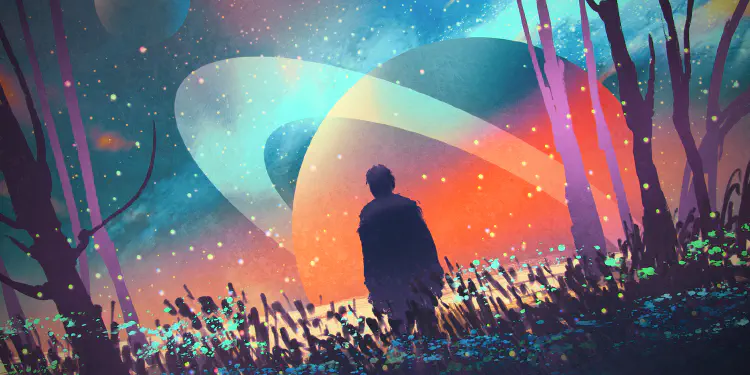Gameplay, or Fiction First?
Sometimes, I’m wrong
Have you ever held a belief which you knew was wrong, yet sincerely held onto it anyways? For me, this is one of those cases.
What. TF. Are you talking about, Chuck?
I’m talking about game conception and ideation. While I’m not going to be all designery here, one way to categorize conversations around game design etc would be:
- Fiction - What is this game about?
“I want to make a game about Paintball”
“The player is an archer, …”
“Because in real-life space-travel there’s deadly radiation and space debris, the player will have to build radiation shielding and the spacecraft will randomly blow up when traveling! That’ll be fun.” Etc - Gameplay - What are the game’s “rules” and what does the player do?
“Tap this button, and a force pushes everything nearby away”
“Pull this container back and it loads a spring force. Release it and it shoots the contents forward!”.
“Every time the player hears ‘Red Light’ they have to stop moving or they die.”
Etc
Note that by “fiction” I don’t mean “story” or “narrative”. I’m talking about what all these things on the screen are supposed to be, and what they’re supposed to be doing. When the player pulls the controller’s trigger, did the player’s character fire a bullet at a real enemy, or a shoot paintball at their best friend? Same gameplay, two different fictions.
A little bit of Game Design Theory stuff
Actual real Game Designers (ARGDs) have academic terms for Gameplay of course. They talk about things like MDA framework.
MDA is a TLA for…
- Mechanics, that’s what I’m talking about with Gameplay.
- Dynamics flow from the game’s mechanics.
- Aesthetics flow from the player’s experience of the dynamics.
Depending on the Player Archetype, a game’s MDAs form a fun/satisfying/etc experience, or they don’t.
A little bit of real stuff
[Here’s where I start being wrong] I have a huge pet peeve when people bring forth game ideas formed around fictions and assume the idea will be fun. (Especially, when said fiction-based ideas come from people in the industry.)
“Let’s make a game about THIS really cool thing. And of course, because in real life THIS thing does SOMETHING, we can make a gameplay mechanic for the player to do that SOMETHING, too!”
I admit it’s the “normal” way to think about such things. We’re entertained by a fictional idea, so of course we’d want to translate that idea into game form.
Okay back to the academia
Game Design is already hard to get right. ARGDs talk about Game Design being a “second order problem”. Players Experience MDA in that order. M->D->A.
But, Game Designers are forced to design in the reverse order. The Player Archetype is a “known” and thus ARGDs can infer appropriate and fun Aesthetics. A Game Designer’s input to the system is the game’s mechanics. They can’t design “fun”. They design thing (Mechanics) creates the thing (Dynamics) that creates the fun (Aesthetics). That’s two leaps. It’s a “Second Order” problem.

Okay back to the real stuff. I digress
Amazing, but true: it is impossible to predict if something’s going to be fun. Really, the only way to find out is to try it. Try the experience. Prototype it. All kinds of gameplay ideas we expect to be fun fall flat. All kinds of things you think are gna suck, end up being fun to a player. But, please for the love of dogs, prototype it first. Game success is predicated on creative success, your #1 job is to reduce creative risk (unless you work at Valve, then your #1 thing is hiring.)
We call such up-front designing absent any iteration loops “throwing the game design over the wall”. You find out if the game’s fun, in production, once assembled. Maybe. Probably not.
Fiction First?
The moment you bring fiction into it, you’ve tied your hands on mechanics. We agree Game Design is hard enough already, right? So why kneecap yourself before you’ve even started? “The player is driving a fire truck” -> “so… I guess we can’t do the fly-to-the-moon and dive-under-water mechanics… unless we want to say its a magical fire truck.” Bad dog!
And this is why games based on movies are really hard to make fun, right? If your fiction came first, so your characters are Transformers Robots or Players caught in diabolical & deadly children’s games, you’re boxed in. I don’t want to say these games tend to suck, but these games tend to suck. The fiction boxed in the gameplay.
So, in my (wrong) worldview Fiction->Gameplay flirts with disaster. Begs it. Do it, and the moon flies away. Cats inherit the Earth and drive it into the Sun. Etc.

Sure, it’s not an autofail. It might randomly work out. But no one knows if it will, you have no control.
This the genesis of most games. We start with “okay so it’s a player who’s fighting Aliens on this ring world” and then mechanics flow from there. Maybe it’s fun and spawns 15 sequels, or maybe its an E_FAIL.
Gameplay First!
So then, how do we end up with a game that doesn’t suck?
(Me, strenuously raising my hand to answer)
We start with the result we’re aiming for - we start with the fun and work our way back. Ahah! Gameplay THEN Fiction.
In this worldview, the role of Fiction is to convey the rules of the game to the player in a way that makes the rules intuitive. Often, the fiction allows the player to map gameplay rules (mechanics) back to real world experiences.
Gameplay:
Pull this thingy back and it loads a spring force. Release it and it shoots forward!
Fiction:
We’ll call it a slingshot. The slingshot fiction explains the gameplay in a natural, intuitive way.
UI Designers call this Skeuomorphism.
Skeuomorphism is where an object in software mimics its real world counterpart in form and function. The “trash can” is a commonly recognized as a skeuomorphic object.
Given a blank slate, we start with just shapes - circles, squares, etc. We have no idea what they are yet, our gameplay can go anywhere. So, bounce some ideas around – and prototype them. Only when it’s fun do we marry our mechanics to fictions. Incrementally, as we prototype. Ideally we’ll try 20 things, keep the best one and toss the other 19. Repeatedly, until we have a fun gameplay system. Each time, a little bit of fiction settles in over the mechanics. Who’s a good dog? You are!!
My former PopCap colleague, Scott Seigel, has a great document about this part of the process.
Or, just watch Scott’s discussion of it. I haven’t watched it yet, but you should. Right now. It’s probably great.
So, how am I wrong?
I talk about these sorts of things often with a former colleague of mine, Amy, a Creative Director and now Producer. Her point (she’s right) is that there’s a lot more nuance to the creative process than I give credit. (By trade, I’m an Engineer and not an actual real life game designer, so what do you expect? Gez.) Sometimes the fiction is important, or even critical - to the fun. Microsoft Flight Simulator is very successful, of course it didn’t originate from circles and triangles.
And then, there’s this. Another great read is the deconstruction of the Kim Kardashian game.
Filling in this Mad Lib-like framework will help to see if a game hits all these notes:
In this game, I: <Core Loop>
To: <Short-Term Progression>
That helps me: <Medium-Term Goals>
That lets me: <Aspiration>
Let’s fill in this framework for Kim Kardashian: Hollywood.
In this game, I: Use energy to perform game actions
To: Complete quests and level up
That helps me: Unlock new locations and cities
That lets me: Become an A-List celebrity
See what’s driving the player’s forward progress? The Aspiration?
Fiction is.
I am wrong.


